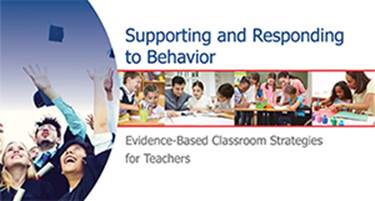Classroom Systems
Classrooms are where our students live and learn. Students thrive on the systems that are in place, and feel comfortable in learning environments with routines that teachers have established.
Five Guiding Principles for Classroom PBIS
- Good teaching is one of the best behavior management tools we have.
- Apply three-tiered prevention logic to classroom setting.
- Link classroom to school-wide expectations through routines & procedures.
- Teach social skills like academic skills.
- Build systems to support through sustained use of effective practices.
Supporting and Responding to Students’ Needs: Evidence-Based Practices for Educators
This guide summarizes evidence-based, positive, and proactive practices that support and respond to students’ social, emotional, and behavioral (SEB) needs in classrooms and similar teaching and learning environments (e.g., small-group activity).
Within a multi-tiered system of support (MTSS) framework, educators can:
- Implement these practices for all students to provide universal support (Tier 1),
- Target practices to support small groups of students with similar needs (Tier 2), and
- Intensify and individualize practices further to meet specific needs of individual students (Tier 3).
These practices help educators prioritize instruction; promote meaningful and equitable outcomes; and support students’ SEB and academic growth.
What needs to be in place before I can expect these strategies to work?
The effectiveness of these classroom strategies are maximized when:
- Implemented within a school-wide multi-tiered behavioral framework (MTBF), such as school-wide PBIS;
- Classroom and school-wide expectations and systems are directly linked;
- Classroom strategies are merged with effective instructional design, curriculum, and delivery;
- Classroom-based data are used to guide decision making.
Three main parts to this guide on classroom practices:
- Steps to Support and Respond to Students’ SEB Needs. The Steps to Support and Respond to Students’ SEB Needs (Figure 2) is a graphic organizer to guide the implementation of the practices and provides hyperlinks to tables that describe each practice.
- Practice Tables. For each practice, the corresponding table describes critical features, provides examples and non-examples, and shares links to free resources to support implementation.
Self-Assessment and Action Plan. The self-assessment provides an opportunity to consider implementation of each practice and guides the user back to the tables that will be most useful. The corresponding action plan provides a template for educators to identify priority practices and document action steps to support implementation.
Download Supporting and Responding to Behavior: Evidence-Based Classroom Strategies for Teachers
“5 Practically Good Ideas for Any Educational Reality" Webinar
With uncertainty about what reality will look like in schools over the course of the pandemic, this video presentation by Dr. Clay Cook focuses on 5 evidence-based proactive classroom management strategies that are practically good ideas under any reality during these years:
- Positive greetings
- Precorrection
- Wise performance-based feedback
- Voice and choice
- Classwide motivation system
Although under ideal circumstances, all 5 strategies could be consistently delivered to all students, each year of the pandemic may continue to present some challenges with regard to time and delivery. Concrete examples of what it looks like to deliver these strategies either remotely or in-person are provided.
This video presentation emphasizes having an equity mindset that involves identifying students who need and can benefit from certain strategies the most and planning to implement it with those students. To facilitate successful use of the strategies, a planning template is provided to help educators detail what it will look like to use them as part of routine instruction.

